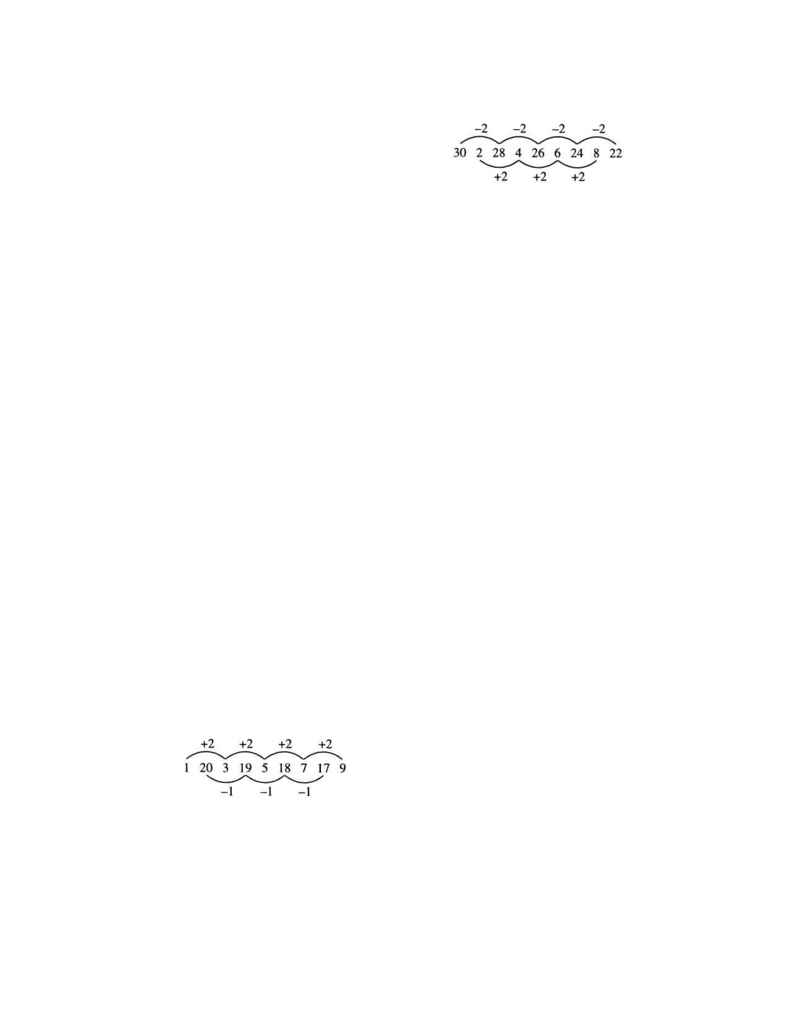
T
HE
E
XAMS
163
39. (A)
This series is the number 17 separated
by numbers increasing by 1, beginning with
the number 3. If the series were continued for
two more numbers, it would read: 17 3 17 4 17
5 17 6 17. Your answer must include the next
number in the increasing series and the 17 that
follows it.
40. (E)
The numbers in this series are increas-
ing, first by 1 and then by 2. If the series were
continued for two more numbers, it would
read: 1 2 4 5 7 8 10 11 13. In some more-
difficult-to-visualize series, you may find it
helpful to diagram the ongoing action. Thus,
you could readily determine the correct an-
swer to this question by writing:
+1 +2 +1 +2 +1 +2 +1 +2
1
2
4
5
7
8
10
11
13
41. (B)
In this series, the number repeats and
then decreases by 1. If the series were contin-
ued for two more numbers, it would read: 21
21 20 20 19 19 18 18 17. The answer includes
the repeat followed by the decreased number.
42. (D)
There are really two alternating series
here. One series increases by 2, while the
alternating series decreases by 1. If the first
series were continued, it would read: 1 3 5 7 9;
the other series continued would read: 20 19 18
17. Combined as a single series, the series
would continue: 1 20 3 19 5 18 7 17 9. If you
find this type of question difficult, consider the
possibility of alternating series. The best solu-
tion of alternating series is a diagram:
43. (E)
Here we also have alternating series; the
first series decreases by 2, while the alternat-
ing series increases by 2. Thus, one series
would read: 30 28 26 24 22; the other would
read: 2 4 6 8. Together, it would read: 30 2 28
4 26 6 24 8 22. Diagrammed, it looks like this:
44. (A)
This alternating series question has a
slightly different rhythm, but after dealing
with a few alternating series questions, you
should easily see: 5 6 7 8 9 10 and 20 19 18.
Once you recognize the pattern of alternation,
you know that the continued series reads: 5 6
20 7 8 19 9 10 18.
45. (C)
This series is similar to those in question
44; they just begin at different points. Contin-
ued, it reads: 9 10 1 11 12 2 13 14 3. In
answering, you must be careful to pick up the
total series at the proper place.
46. (A)
This question involves a single series
with alternating steps. Diagrammed, it looks
like this:
+2
+3
+2
+3
+2
+3
+2
+3
4
6
9
11
14
16
19
21
24
47. (B)
This series is similar to those in ques-
tions 44 and 45 except that all numbers in-
crease by a factor of 2 instead of 1, and there is
the repetition element. Continued, the series
would read: 8 8 1 10 10 3 12 12 5.
48. (A)
This is a single series with varying in-
creasing steps. It is quite difficult to answer
without a diagram, but it's very simple with
one, as illustrated:
+1 +2 +1 +3 +1 +4 +1 +5 +1 +6 +1
20 21 23 24 27 28 32 33 38 39 45 46.
By the time you have diagrammed to the point
of choosing an answer, you should have a clear
understanding of the pattern and be able to
continue with confidence.
